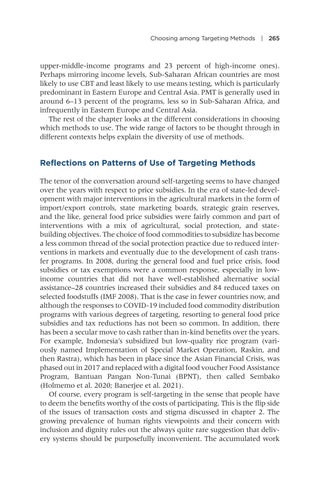Choosing among Targeting Methods | 265
upper-middle-income programs and 23 percent of high-income ones). Perhaps mirroring income levels, Sub-Saharan African countries are most likely to use CBT and least likely to use means testing, which is particularly predominant in Eastern Europe and Central Asia. PMT is generally used in around 6–13 percent of the programs, less so in Sub-Saharan Africa, and infrequently in Eastern Europe and Central Asia. The rest of the chapter looks at the different considerations in choosing which methods to use. The wide range of factors to be thought through in different contexts helps explain the diversity of use of methods.
Reflections on Patterns of Use of Targeting Methods The tenor of the conversation around self-targeting seems to have changed over the years with respect to price subsidies. In the era of state-led development with major interventions in the agricultural markets in the form of import/export controls, state marketing boards, strategic grain reserves, and the like, general food price subsidies were fairly common and part of interventions with a mix of agricultural, social protection, and state- building objectives. The choice of food commodities to subsidize has become a less common thread of the social protection practice due to reduced interventions in markets and eventually due to the development of cash transfer programs. In 2008, during the general food and fuel price crisis, food subsidies or tax exemptions were a common response, especially in lowincome countries that did not have well-established alternative social assistance–28 countries increased their subsidies and 84 reduced taxes on selected foodstuffs (IMF 2008). That is the case in fewer countries now, and although the responses to COVID-19 included food commodity distribution programs with various degrees of targeting, resorting to general food price subsidies and tax reductions has not been so common. In addition, there has been a secular move to cash rather than in-kind benefits over the years. For example, Indonesia’s subsidized but low-quality rice program (variously named Implementation of Special Market Operation, Raskin, and then Rastra), which has been in place since the Asian Financial Crisis, was phased out in 2017 and replaced with a digital food voucher Food Assistance Program, Bantuan Pangan Non-Tunai (BPNT), then called Sembako (Holmemo et al. 2020; Banerjee et al. 2021). Of course, every program is self-targeting in the sense that people have to deem the benefits worthy of the costs of participating. This is the flip side of the issues of transaction costs and stigma discussed in chapter 2. The growing prevalence of human rights viewpoints and their concern with inclusion and dignity rules out the always quite rare suggestion that delivery systems should be purposefully inconvenient. The accumulated work


